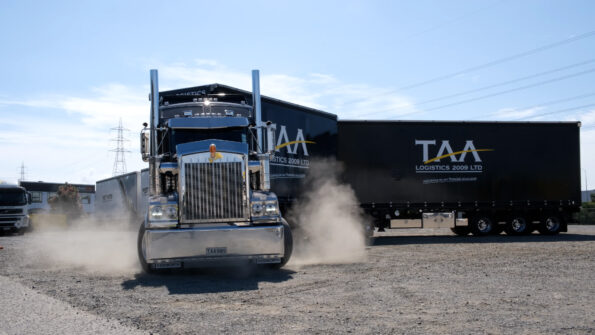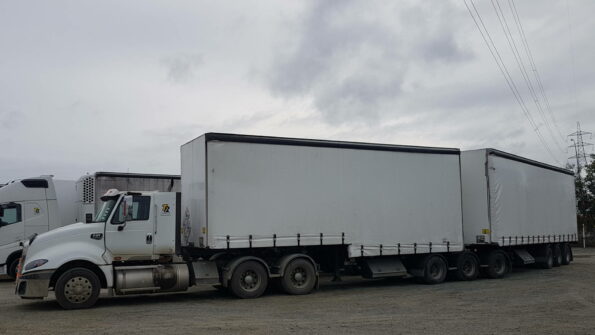Truck combinations range in size and are defined by the number of trailers they pull and the coupling they use to connect them. Trailers are coupled either using a fifth wheel (a B coupling) or a bolt and pin coupling with a dolly (an A coupling). If you want to learn about how to couple a trailer, check out this trailer coupling training course. We covered dog trailers here. This article is about semitrailer couplings.
Prime mover + one trailer using a fifth wheel = semitrailer
Prime mover + two semitrailers using a fifth wheel = B-train or B-double
Prime mover + more than two semitrailers = B-triple
In contrast, an A-double is a semitrailer pulling another trailer using an A coupling.
Combinations can also be BAB, AB or A-double. These simply describe at which point in the combination each coupling occurs. For example, a BAB-quad would be a prime mover with a B-train at the front, then a bolt and pin coupling and another B-train behind, giving four total trailers.
So, a B-double is a prime mover with a semitrailer connected via a fifth wheel. That trailer has a dolly with a fifth wheel at the rear, and another semitrailer is connected to that.
What does a b-double look like?


How is a B-double configured?
B-doubles can be up to 26m long (including the prime mover) with 7, 8 or 9 axles, 4.3m tall and 2.5m wide. The distance from the rear of the rear trailer to the front kingpin must be no longer than 20.6m.
B-doubles are not road trains.
The trailers are coupled with the minimum distance required to allow the unit to turn, but keeping the distance as short as possible to improve air flow and aerodynamics.
What are the advantages of a B-double?
B-doubles maximise manoeuvrability and flexibility as they can be heavier than a semitrailer due to having more wheels in contact with the ground. A b-double tandem drive quad-axle can be up to 77,500kg under higher mass limits, 51,500kg if eligible for CML, but generally 50,000kg, whereas the largest semitrailer maxes out at 46,500kg.
B-doubles are relatively more stable than a truck using an A coupling pulling a dog trailer. B couplings (fifth wheels) are roll coupled, which means that if the trailer starts to roll, it also has to roll the prime mover, whereas A couplings can roll independently.
When carrying dangerous goods, each trailer of a B-double is classified as a separate vehicle, therefore segregation requirements are easier.
What licence do you need to drive a B-double?
You need an MC class licence, therefore will need to pass a CBT course in a B-double vehicle.
What are key differences between a B-double and a semitrailer?
A B-double has two trailers vs one on a semitrailer.
When reversing a B-double, the steering inputs are the opposite of that for a semitrailer for the rear trailer.
The fifth wheel on a B-double’s rear trailer is closer to the apron (the front of the trailer) than on a regular semitrailer.
The suzi cables connect under the rear trailer and into the sockets on the rear of the fifth wheel of the front trailer, they don’t connect to the rear face of the front trailer.
The rear trailer moves around more than a semitrailer due to the ‘whip crack’ effect.
Each B-double trailer has its own trailer legs.
